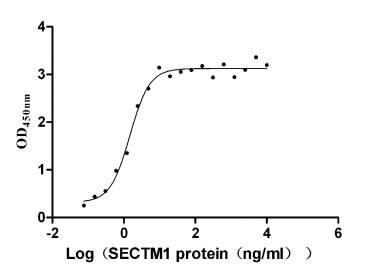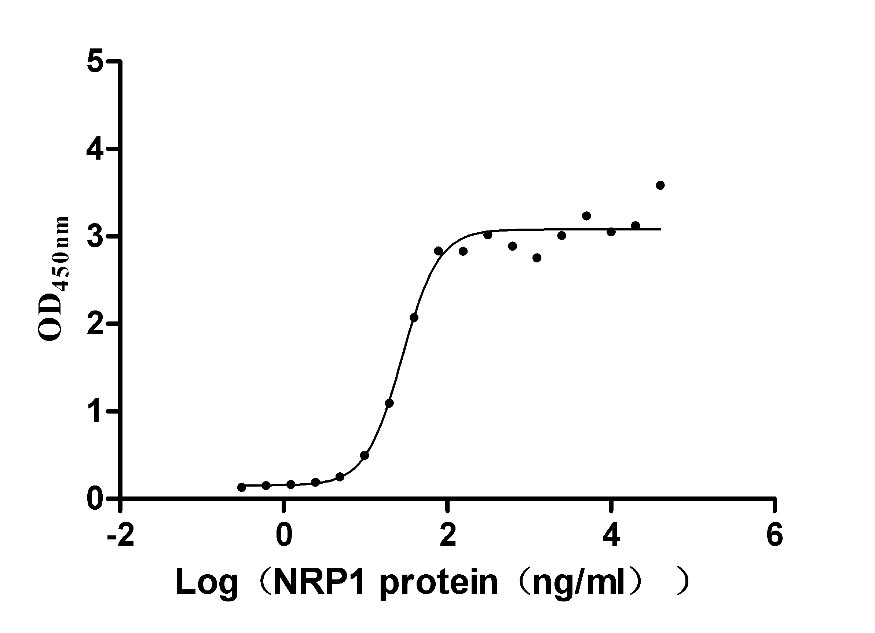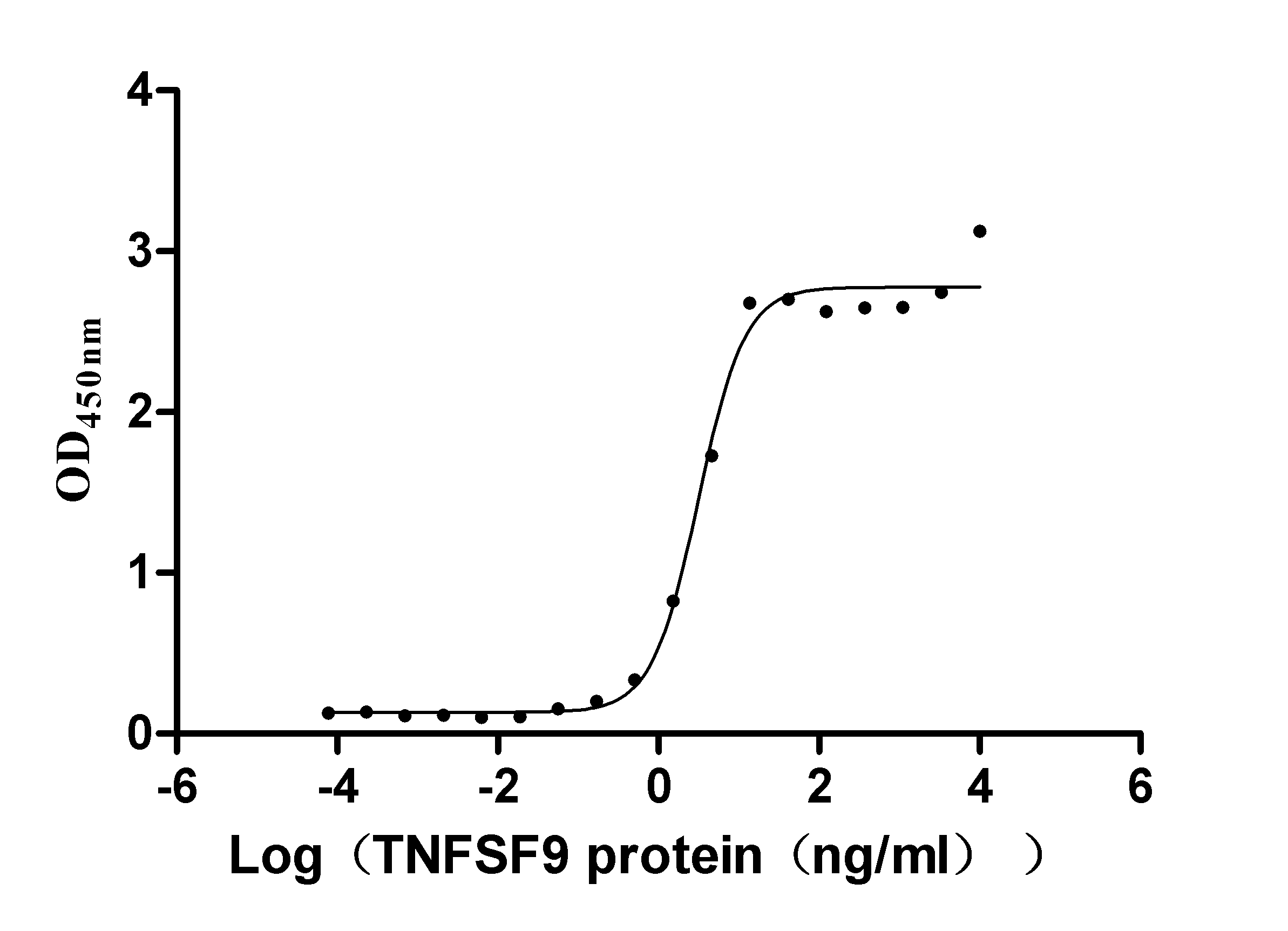Recombinant Mouse Proteinase-activated receptor 1 (F2r), partial
-
中文名称:小鼠F2r重组蛋白
-
货号:CSB-YP007924MO1
-
规格:
-
来源:Yeast
-
其他:
-
中文名称:小鼠F2r重组蛋白
-
货号:CSB-EP007924MO1
-
规格:
-
来源:E.coli
-
其他:
-
中文名称:小鼠F2r重组蛋白
-
货号:CSB-EP007924MO1-B
-
规格:
-
来源:E.coli
-
共轭:Avi-tag Biotinylated
E. coli biotin ligase (BirA) is highly specific in covalently attaching biotin to the 15 amino acid AviTag peptide. This recombinant protein was biotinylated in vivo by AviTag-BirA technology, which method is BriA catalyzes amide linkage between the biotin and the specific lysine of the AviTag.
-
其他:
-
中文名称:小鼠F2r重组蛋白
-
货号:CSB-BP007924MO1
-
规格:
-
来源:Baculovirus
-
其他:
-
中文名称:小鼠F2r重组蛋白
-
货号:CSB-MP007924MO1
-
规格:
-
来源:Mammalian cell
-
其他:
产品详情
-
纯度:>85% (SDS-PAGE)
-
基因名:
-
Uniprot No.:
-
别名:F2r; Cf2r; Par1; Proteinase-activated receptor 1; PAR-1; Thrombin receptor
-
种属:Mus musculus (Mouse)
-
蛋白长度:Partial
-
蛋白标签:Tag type will be determined during the manufacturing process.
The tag type will be determined during production process. If you have specified tag type, please tell us and we will develop the specified tag preferentially. -
产品提供形式:Lyophilized powder
Note: We will preferentially ship the format that we have in stock, however, if you have any special requirement for the format, please remark your requirement when placing the order, we will prepare according to your demand. -
复溶:We recommend that this vial be briefly centrifuged prior to opening to bring the contents to the bottom. Please reconstitute protein in deionized sterile water to a concentration of 0.1-1.0 mg/mL.We recommend to add 5-50% of glycerol (final concentration) and aliquot for long-term storage at -20℃/-80℃. Our default final concentration of glycerol is 50%. Customers could use it as reference.
-
储存条件:Store at -20°C/-80°C upon receipt, aliquoting is necessary for mutiple use. Avoid repeated freeze-thaw cycles.
-
保质期:The shelf life is related to many factors, storage state, buffer ingredients, storage temperature and the stability of the protein itself.
Generally, the shelf life of liquid form is 6 months at -20°C/-80°C. The shelf life of lyophilized form is 12 months at -20°C/-80°C. -
货期:Delivery time may differ from different purchasing way or location, please kindly consult your local distributors for specific delivery time.Note: All of our proteins are default shipped with normal blue ice packs, if you request to ship with dry ice, please communicate with us in advance and extra fees will be charged.
-
注意事项:Repeated freezing and thawing is not recommended. Store working aliquots at 4°C for up to one week.
-
Datasheet :Please contact us to get it.
相关产品
靶点详情
-
功能:High affinity receptor for activated thrombin coupled to G proteins that stimulate phosphoinositide hydrolysis.
-
基因功能参考文献:
- PAR-1 plays an important role in the development of diabetic nephropathy (DN) and PAR-1 might therefore be an attractive therapeutic target to pursue in DN. PMID: 27618774
- Experimental TCDD-elicited steatohepatitis is associated with coagulation cascade activation and PAR-1-driven hepatic inflammation and fibrosis. PMID: 27613713
- PAR1 in its inactive unligated state functions as a scaffold for TGFbetaRII to downregulate TGF-beta signaling, and thereby promote embryonic stem cell transition to functional endothelial cells. PMID: 27866874
- this study shows that poly I:C treated PAR-1-/- mice given the thrombin inhibitor dabigatran etexilate exhibited less IFNbeta and CXCL10 expression in the spleen and plasma PMID: 27820939
- Brain water content in the ipsilateral hemisphere and the tumor mass were significantly lower in PAR-1 KO than WT mice at day 12 after implantation of glioma cells. PMID: 26463974
- The results of this study suggested that polarized microglia occur dynamically after ICH and that PAR-1 plays a role in the microglia activation and polarization. PMID: 27206851
- our findings define a detrimental role of thrombin-activated PAR-1 in wound healing in mice with spinal cord injuries. PMID: 28122028
- Thrombin upregulates LCN2 through protease-activated receptor-1 activation and causes brain damage. PMID: 26869387
- Matrix metalloproteinases (MMP) are effectors of hippocampal neuroplasticity in the adult central nervous system and that the MMP-1/protease-activated receptor-1 axis may play a role in neurogenesis following physiological and/or pathological stimuli. PMID: 26783471
- Data indicate an involvement of protease-activated receptor-1 in the neuroinflammation mediated by Eomes(+) CD4(+) T cells. PMID: 26436530
- Bladder PAR activation elicits urothelial MIF release and urothelial MIF receptor signaling at least partly through CXCR4 to result in abdominal hypersensitivity without overt bladder inflammation PMID: 26020638
- Data suggest that the pro-fibrotic effects of protease-activated receptor PAR-1 require the presence of protease-activated receptor PAR-2. PMID: 25689283
- Thrombin-PAR1 signaling, via nitric oxide and EPCR, promotes hematopoietic stem cell (HSC) mobilization. aPC-EPCR-PAR1 signaling promotes HSC retention in bone marrow. PMID: 26457757
- Colonic adenocarcinoma growth was reduced in PAR-1-deficient mice. Stromal cell-associated PAR-1 as one thrombin target important for tumor outgrowth. PMID: 26238780
- Interference with the thrombin-PAR1 system does not reduce the adverse effects of blood on germinal cells of the immature mouse brain. PMID: 25649264
- Protease activated receptor-1 deficiency diminishes bleomycin-induced skin fibrosis PMID: 24842054
- impairs host defense during pneumococcal pneumonia PMID: 23270594
- this study demonstrated that PAR1-mediated protection against H. pylori gastritis requires bone marrow-derived cells. PMID: 24866378
- these data demonstrate a key role for PAR-1 during S. pneumoniae lung infection that is mediated, at least in part, by influencing multiple downstream inflammatory mediators. PMID: 25948816
- Results demonstrate that PAR1 activation alters the ability of denervated neurons to increase their excitatory synaptic strength in a homeostatic manner PMID: 25086265
- Deletion of PAR-1 does not confer chondroprotection in a medial meniscus destabilization model of osteoarthritis. PMID: 25200274
- The absence of PAR-1 results in a slower skeletal muscle contractile phenotype, likely due to an increase in type I and a decrease in type IIb/x fiber numbers. PMID: 24692104
- Study examined the effect of a deficiency in PAR1 or PAR2 on oxsackievirus B3-induced myocarditis and found that PAR1 knockout mice had increased cardiac injury whereas PAR2 knockout mice had decreased cardiac injury supporting the notion that PARs modulate the innate immune response and can have both positive and negative effects on TLR-dependent responses. PMID: 24759133
- PAR1 signalling can contribute to the regulation of macrophage recruitment, impacting the fibrotic response of the liver to recurrent injury. PMID: 24475094
- PAR1 is expressed in the mouse prostate and its activation by PAR1-TF elicits immunomodulatory effects during ethanol-DNBS-induced prostatitis. PMID: 24459330
- These results show that endogenous PAR-1 facilitates bacterial growth and dissemination during murine melioidosis, which is associated with increased cell influxes. PMID: 24239704
- The findings point to experience-specific shifts in PAR1-G protein coupling in the amygdala as a novel mechanism regulating neuronal excitability and fear. PMID: 23032873
- Simultaneous depletion of PAR-1 and PAR-3 almost completely inhibited epithelial-mesenchymal transition in bleomycin-induced lung fibrosis. PMID: 23739922
- hMPV fusion protein can be cleaved by furin thus suggesting that PAR1 could have an effect on viral infectivity in addition to its immunomodulatory properties. PMID: 24015257
- PAR2, and not PAR1, contributes to post-ischemic blood flow restoration and collateral remodelling in a hind limb ischemia model. PMID: 23637930
- these data point to a novel kallikrein 6 -signaling axis in neurons that is mediated by PAR1 and PAR2 and is positioned to contribute to neurodegeneration PMID: 23647384
- Noncanonical MMP-1-PAR1 signaling resulted in the opposite effect and led to a dedifferentiated phenotype via a different G protein pathway. MMP-1-PAR1 significantly stimulated hyperplasia and migration of SMCs. PMID: 23814055
- inhibition of the SOCE downstream target CaM kinase kinase beta (CaMKKbeta) or knockdown of AMPKalpha1 suppressed PAR-1-mediated phosphorylation of p38beta and hence STIM1. PMID: 23625915
- PDZ-RhoGEF and LARG are essential for embryonic development and provide a link between thrombin and LPA receptors and Rho activation. PMID: 23467409
- Upon activation of protease activated receptor 1 (PAR1), an increase in intracellular Ca2+ concentration leads to an opening of Best1 channels and subsequent release of glutamate in cultured astrocytes. PMID: 23062602
- The tissue factor/thrombin/PAR-1 pathway enhances IFN-beta expression and contributes to the innate immune response during single-stranded RNA viral infection. PMID: 23391721
- Activating PAR1 by administering the agonist TFLLR-NH2 decreased survival and increased lung inflammation after influenza infection. PMID: 23202729
- PAR-1 contributes to the brain injury induced by global cerebral ischemia, which may be related to activation of mitogen-activated protein kinases PMID: 22811450
- Trypsin inhibited LPS signaling PAR-independently via degradation of TLR4 accessory molecules PMID: 22771700
- demonstrate that beta-adrenergic receptor stimulation leads to MMP-13 transactivation of protease-activated receptor 1 in both cardiac fibroblasts and cardiomyocytes PMID: 22610965
- thrombin receptor (F2r), a protease-activated G protein-coupled receptor required for vascular development, functions as a negative regulator during hematopoietic development. PMID: 22521721
- Study identified key molecular determinants for PAR1 interactions with G(q/11), and findings support a model where G(q/11), G(i/o) or G(12/13) each bind to distinct sites within the cytoplasmic regions of PAR1. PMID: 22306780
- the microbiota-induced extravascular TF-PAR1 signalling loop is a novel pathway that may be modulated to influence vascular remodelling in the small intestine PMID: 22407318
- PAR2 regulates the PAR1 hyperplastic response to arterial injury leading to stenosis. PMID: 21940952
- These findings implicate MMP-1 as an important activator of PAR1 in sepsis and suggest that therapeutics that target MMP1-PAR1 may prove beneficial in the treatment of sepsis. PMID: 21591259
- PAR-1 protects the host against severe Helicobacter-induced gastritis [PAR-1]. PMID: 19706295
- RANTES may contribute to modulation of IL-13 production and PAR expression in mast cells. PMID: 21074454
- EPCR interacts with the ternary TF coagulation initiation complex to enable PAR1,2 signaling. PMID: 21149441
- VASP deficiency leads to a more profound endothelial barrier disruption and delayed recovery after activation of thrombin PAR-1 receptor. PMID: 20945373
- PAR-1 negatively regulates the expression of the Maspin tumor-suppressor gene in the acquisition of the metastatic melanoma phenotype PMID: 21187389
显示更多
收起更多
-
亚细胞定位:Cell membrane; Multi-pass membrane protein.
-
蛋白家族:G-protein coupled receptor 1 family
-
数据库链接:
KEGG: mmu:14062
STRING: 10090.ENSMUSP00000061754
UniGene: Mm.24816
Most popular with customers
-
Recombinant Macaca fascicularis Angiotensin-converting enzyme (ACE2), partial (Active)
Express system: Mammalian cell
Species: Macaca fascicularis (Crab-eating macaque) (Cynomolgus monkey)
-
Recombinant Human Tumor necrosis factor receptor superfamily member 5 (CD40), partial (Active)
Express system: Mammalian cell
Species: Homo sapiens (Human)
-
Recombinant Human T-cell antigen CD7 (CD7), partial (Active)
Express system: Mammalian cell
Species: Homo sapiens (Human)
-
Recombinant Human Tumor necrosis factor ligand superfamily member 8 (TNFSF8), partial (Active)
Express system: Mammalian cell
Species: Homo sapiens (Human)
-
Recombinant Human Neuropilin-1 (NRP1) (Active)
Express system: Mammalian cell
Species: Homo sapiens (Human)
-
Recombinant Human Tumor necrosis factor ligand superfamily member 9 (TNFSF9), partial (Active)
Express system: Mammalian cell
Species: Homo sapiens (Human)
-
Recombinant Macaca mulatta Semaphorin-4D isoform 1 (SEMA4D), partial (Active)
Express system: Mammalian cell
Species: Macaca mulatta (Rhesus macaque)
-
Recombinant Mouse Transthyretin (Ttr) (Active)
Express system: Mammalian cell
Species: Mus musculus (Mouse)




















